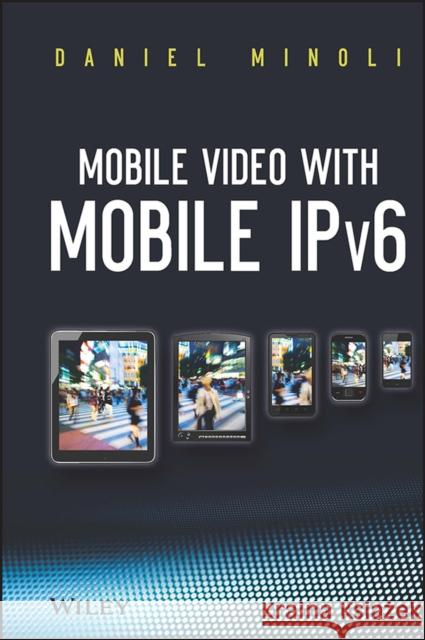Mobile Video with Mobile Ipv6 » książka



Mobile Video with Mobile Ipv6
ISBN-13: 9781118354971 / Angielski / Twarda / 2012 / 296 str.
Mobile Video with Mobile Ipv6
ISBN-13: 9781118354971 / Angielski / Twarda / 2012 / 296 str.
(netto: 364,62 VAT: 5%)
Najniższa cena z 30 dni: 380,76 zł
ok. 16-18 dni roboczych
Bez gwarancji dostawy przed świętami
Darmowa dostawa!
Increased reliance on mobile devices and streaming of video content are two of the most recent changes that have led those in the video distribution industry to be concerned about the shifting or erosion of traditional advertising revenues. Infrastructure providers also need to position themselves to take advantage of these trends. Mobile Video with Mobile IPv6 provides an overview of the current mobile landscape, then delves specifically into the capabilities and operational details of IPv6. The book also addresses 3G and 4G services, the application of Mobile IPv6 to streaming and other mobile video outputs, and closes with a chapter on future directions.
Glosariusz/słownik
PREFACE xi
ABOUT THE AUTHOR xiii
1 THE MOBILE USER ENVIRONMENT: SMART PHONES, PORTABLE MEDIA PLAYERS (PMPs), AND TABLETS 1
1.1 Introduction / 1
1.2 Basic MIPv6 Operation / 3
1.3 Entertainment Video Trends / 10
1.4 Scope of Investigation / 14
Appendix 1.1A: Statistics / 15
Appendix 1.1B: Bibliography / 16
References / 18
2 IPv6BASICS 19
2.1 Overview and Motivations / 19
2.2 Address Capabilities / 23
2.2.1 IPv4 Addressing and Issues / 23
2.2.2 IPv6 Address Space / 24
2.3 IPv6 Protocol Overview / 29
2.4 IPv6 Tunneling / 37
2.5 IPsec in IPv6 / 40
2.6 Header Compression Schemes / 40
2.7 Quality of Service In IPv6 / 44
2.8 Migration Strategies to IPv6 / 45
2.8.1 Technical Approaches / 45
2.8.2 Residential Broadband Services in an IPv6 Environment / 48
2.8.3 Deployment Opportunities / 50
References / 53
3 MOBILE IPv6 MECHANISMS 55
3.1 Overview / 55
3.2 Protocol Details / 63
3.2.1 Generic Mechanisms / 63
3.2.2 New IPv6 Protocol, Message Types, and Destination Option / 67
3.2.3 Modifications to IPv6 Neighbor Discovery / 74
3.2.4 Requirements for Various IPv6 Nodes / 74
3.2.5 Correspondent Node Operation / 77
3.2.6 Home Agent Node Operation / 82
3.2.7 Mobile Node Operation / 82
3.2.8 Relationship to IPV4 Mobile IPv4 / 86
References / 88
4 ADVANCED FEATURES AND FUNCTIONS OF MIPv6–RELATED PROTOCOLS PART 1 89
4.1 Network Mobility Basic Support Protocol / 89
4.2 Mobile IPv6 Fast Handovers / 94
4.2.1 General Approach / 94
4.2.2 3G Networks Approach / 102
4.3 Multiple Care–of Addresses Registration / 104
4.3.1 Overview / 104
4.3.2 MIPv6 Extensions / 105
4.4 Mobile Node Identifier Option for MIPv6 / 106
4.5 Mobile IPv6 Management Information Base / 107
4.6 Sockets API For Mobile IPv6 / 109
References / 111
5 ADVANCED FEATURES AND FUNCTIONS OF MIPv6–RELATED PROTOCOLS PART 2 112
5.1 Dual–Stack MIPv6 / 112
5.2 Hierarchical Mobile IPv6 / 116
5.3 Flow Bindings in Mobile IPv6 and NEMO / 119
5.4 Multihoming Approaches in NEMO / 122
5.5 Bootstrapping MIPv6 Information / 127
5.5.1 Basic Approach / 128
5.5.2 Mobile IPv6 Bootstrapping in Split Scenario / 128
5.6 Diameter Mobile IPv6 / 132
5.6.1 RFC 5447 Authentication Using AAA Infrastructures / 132
5.6.2 RFC 5778 Authentication Using the Internet Key Exchange v2 / 134
5.7 Miscellaneous MIPv6 Capabilities / 137
5.7.1 Mobile IPv6 Vendor Specific Option / 137
5.7.2 MIPv6 Experimental Messages / 137
5.7.3 Service Selection for MIPv6 / 138
References / 139
6 PROXY MOBILE IPv6 141
6.1 Basic Proxy Mechanisms / 144
6.1.1 Proxy Mobile IPv6 Protocol Overview / 145
6.1.2 Signaling Call Flow / 147
6.1.3 PM IPv6 Protocol Security / 149
6.1.4 Messages / 149
6.1.5 Operations / 150
6.1.6 Summary / 153
6.2 Transient Binding / 153
6.2.1 Overview / 153
6.2.2 Use of Transient Binding Cache Entries / 155
6.3 Local Mobility Anchor Discovery / 156
6.4 Localized Routing/Direct Routing / 157
6.5 IPv4 Support for Proxy Mobile IPv6 / 159
6.5.1 Overview / 159
6.5.2 IPv4 Home Address Mobility Support / 162
6.5.3 IPv4 Transport Support / 164
6.5.4 Localized Routing IPv4 Considerations / 166
Appendix 6A: Network–Based Localized Mobility Management / 167
6A.1 Background / 167
6A.2 The Local Mobility Problem / 168
References / 171
7 SECURITY CONSIDERATIONS FOR MIPv6 173
7.1 Using IPsec to Protect MIPv6 Signaling Between Mobile Nodes and Home Agents / 173
7.1.1 Payload Packets / 174
7.1.2 Required Capabilities / 175
7.2 MIPv6 Operation with IKEv2 and Revised IPsec Architecture / 176
7.2.1 Packet Formats / 176
7.2.2 Requirements / 176
7.3 Securing Mobile IPv6 Route Optimization Using a Static Shared Key / 181
7.4 Enhanced Security in Route Optimization / 182
7.5 Mobile IPv6 and Firewalls / 185
7.6 Non–IPsec Authentication Protocol For MIPv6 / 185
7.7 IP Address Location Privacy / 186
7.8 Use of Secure Neighbor Discovery / 187
7.9 Authentication, Authorization, and Accounting in MIPv6 / 188
7.10 Diameter Proxy Mobile IPv6 Approaches / 188
References / 189
8 MOBILE VIDEO AND VIDEO STREAMING SERVICES 190
8.1 Overview / 190
8.1.1 Quality of Experience Aspects / 195
8.1.2 QoS Aspects / 204
8.2 3/4G Services and Video Applications / 208
8.2.1 IETF IPv4/Mobile IPv4/IPv6 / 209
8.2.2 Universal Mobile Telecommunications System / 209
8.2.3 Long Term Evolution / 210
8.3 Streaming Protocols and Approaches / 223
8.3.1 Streaming / 223
8.3.2 Content Distribution Networks / 234
8.3.3 P2P Networks / 235
8.3.4 Cloud Computing / 236
8.4 MIPv6 Support in CDMA2000/WiMAX Video Environments / 238
8.5 Other Mobile Video Approaches / 240
8.5.1 ETSI Digital Video Broadcast Handheld / 240
8.5.2 Open Mobile Video Coalition Mobile Digital TV / 245
References / 252
GLOSSARY 255
INDEX 273
DANIEL MINOLI has worked extensively in video engineering, design, and implementation at organizations including Telcordia Technologies (Bellcore), Stevens Institute of Technology, AT&T, and Gartner/DataPro. He taught at Stevens Institute of Technology, New York University, and Rutgers University. Mr. Minoli has authored columns for Computerworld, Network World, and Network Computing magazines. He has served as a technical Expert Witness and as an Advisor to high–tech Venture Capitalists.
Explores the technology, protocols, and deployment strategies for IPv6–based mobile video
IP–based video distribution is expanding in the number of delivery methods (streaming, IPTV), the content creation methods (social media, user–generated video, web–original video), and the display methods (smart TVs, smartphones, tablets). Until 2011, mobile technology was supported largely using IP Version 4 (IPv4), but increasing demand left only 1 percent of address space in the pool of available IPv4 address blocks. IPv6 was created to address next–generation services and the exploding user base. It is beginning to be adopted by Google, Facebook, Yahoo!, and Akamai, among others. The deployment of IPv6 coincides with a rapid adoption of mobile devices such as smartphones and tablets.
Mobile Video with Mobile IPv6 is the first book to address Mobile IPv6 with applications to linear and non–linear video distribution. It provides an overview of the current mobile landscape, then delves specifically into the capabilities and operational details of IPv6. The book also addresses 3G and 4G services, the application of Mobile IPv6 to streaming and other mobile video outputs, and takes a look at the future of mobile video.
This timely guide:
- Provides a comprehensive overview of the Mobile IPv6 protocol, including the Basic Mode and its various extensions
- Offers practical suggestions for cost–effective entertainment delivery within existing service provider networks
- Considers evolving shifts in consumer viewing habits
- Suggests new revenue–generating services that can be brought to the market
- Examines security considerations for Mobile IPv6
Mobile Video with Mobile IPv6 is an important resource for planners, CTOs, and engineers at broadcast TV, cable TV, and satellite operations, as well as Internet and ISP providers, telecommunications companies, and wireless providers. It is also a useful tool for set top box developers, storage vendors, content developers, content distribution outfits, and content aggregators.
1997-2025 DolnySlask.com Agencja Internetowa
KrainaKsiazek.PL - Księgarnia Internetowa









